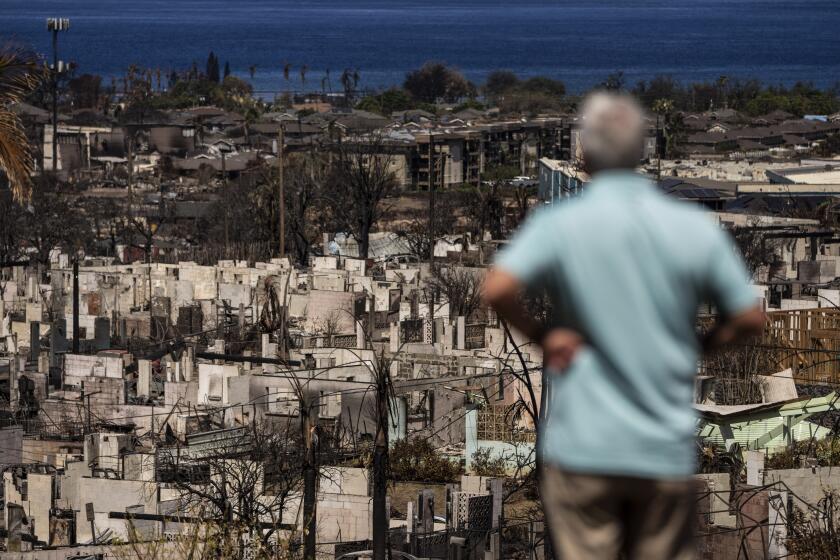Chemical Sensitivity Drives Woman Into Wilds : Health: She says the fresh air on her wind-swept ridge is letting her slowly recover from a debilitating affliction.
Like Thoreau, Peggy Magidson went to the woods because she wished to live simply. But she was driven by chemistry, not philosophy.
Even as autumnal nights chill to the 20s, Magidson lives in a campsite at Frosty Acres Campground, about 20 miles west of Albany in the agrarian hills above the Mohawk Valley. Swaddled in 12 layers of cotton clothing, she sleeps in a hammock strung under hemlocks and beeches. She crawls into a small tent when nights are frigid.
She has taken refuge here from the ubiquitous chemicals of the civilized world. Like the tuberculosis patients who fled to the pine-scented air of the Adirondacks a century ago, Magidson says the fresh air on her wind-swept ridge is letting her slowly recover from a debilitating affliction called Multiple Chemical Sensitivity.
“One day I’m president of a company, the next I’m a derelict on the street,” said Magidson, 43, who ran a telemarketing firm from her New York City apartment until the illness struck three years ago and left her unable to enter her home or any other building without becoming violently ill.
“It was a shock,” she said. “I spent three nights wandering the streets. I felt like something between an animal and a guerrilla warrior.”
Multiple Chemical Sensitivity, now under study by the Environmental Protection Agency, is a controversial ailment.
Some doctors say it’s psychological. And among those who consider it a physical disorder, there is disagreement over what causes it, how to define it, and how to treat it.
“For some new syndrome to gain medical credibility, there has to be some scientific research done on it,” said Dr. Kelley Brix, a chemical exposure expert for the state Health Department. “So far, there hasn’t been much research done on this.”
Advocates like Mary Lamielle, president of the National Center for Environmental Health Strategies in Voorhees, N.J., say the illness afflicts between 15% and a third of the population, with varying severity.
Symptoms are triggered by perfumes, cigarette smoke, car exhaust, photocopier ink, pesticides, mold, plastics, carpeting, polyester, dry cleaning chemicals, floor wax and other common substances.
They include wheezing, sinusitis, sore throats, headaches, rashes, nausea, dizziness, fatigue and impaired memory and concentration.
“The medical community has been trying to discredit this,” said Lamielle, herself a sufferer. “But the trend among researchers is that there does appear to be a physiological basis, although there may be psychological aspects as well.”
Sitting on a mossy rock in the woods, Magidson looks like a pale Gypsy. Her fair skin is lined and at times blotched with red. Her hair, the soft silver of a squirrel’s tail, brushes shoulders wrapped in a ragged beige-and-salmon Navajo print cotton blanket. Her lean body is layered with flannel shirts, sweaters, bleach-stained dungarees and worn leather shoes with broken, knotty laces.
The clothing, as well as the pile of towels Magidson sleeps on, is faded from elaborate cleansings in bleach, vinegar and baking soda.
She stays at least 10 feet from any visitor. She dons a filter mask if someone is wearing perfume, or if she has to go into the nearby restroom and shower cabin or the campground office. She asks an interviewer to write with a pencil, because ink makes her ill.
Oxygen tanks sit propped against a tree stump in case she has breathing difficulty. The only furniture is a metal folding chair and a picnic table piled with supplies beneath a rain tarp.
Yellow leaves drift into cases of bottled water and caffeine-free Coke, staples of Magidson’s special diet, which includes boiled lamb, brown rice and vegetables.
“I used to be a fashionable executive lady, with designer dresses and high heels,” she said, laughing at her Bohemian appearance. “This is not a lifestyle I chose. It’s what I have to do to survive.”
Originally from St. Louis, Magidson went to the University of Michigan and then the School of Visual Arts in New York. She worked as a photo stylist, setting up fanciful tableaux for ads, before she started a telemarketing firm specializing in the environmental cleanup industry.
“She was a polished professional. One of the most dynamic people I know,” said James Trillinger, owner of a New York City telemarketing firm that subcontracted work from Magidson.
Her reverse metamorphosis from urban social butterfly with a growing business to hermit cocooned in cotton in the woods began in 1991.
“I was hit with a biological and a chemical contaminant in my co-op apartment,” she said.
After spending more than $30,000 to have private testing laboratories investigate, the contaminants were identified, she says. She won’t specify them publicly, however, because she has filed lawsuits.
The toxic exposure caused damage that left her extremely sensitive to a wide range of common substances, said Magidson and her physician, Dr. Steven Colby, chief of infectious diseases at Brooklyn Interfaith Medical Center.
“I couldn’t see straight. My sense of balance was off, like I was walking on Jell-0,” she said. “I had a raspy cough, burning in my lungs and nasal passages, and a wild, crazy heartbeat. And it did something weird to my sense of smell, like it was super-magnified.”
Having abandoned her contaminated belongings, given up her business because she could no longer run it and spent all her money on doctors and investigators, Magidson was dependent on charity.
She lived in a friend’s apartment for two years, in a “safe room” sealed from irritating chemicals. When floor-care products in that building made her sick, she appealed to her friend John Fridholm, who let her set up a metal shed on his lakeside property near Schenectady.
“She lived outside here for a while, and was making progress,” Fridholm said. “But then the town came by spraying malathion for mosquitoes, and she had to flee.”
Magidson, who is on welfare, has asked the Schenectady County Department of Social Services to provide her with a trailer furnished to specifications in a 82-page statement on her medical condition from Colby.
“We looked into special housing, but there is no provision in our regulations,” said Richard Staszak, the social services commissioner.
More to Read
Start your day right
Sign up for Essential California for news, features and recommendations from the L.A. Times and beyond in your inbox six days a week.
You may occasionally receive promotional content from the Los Angeles Times.






